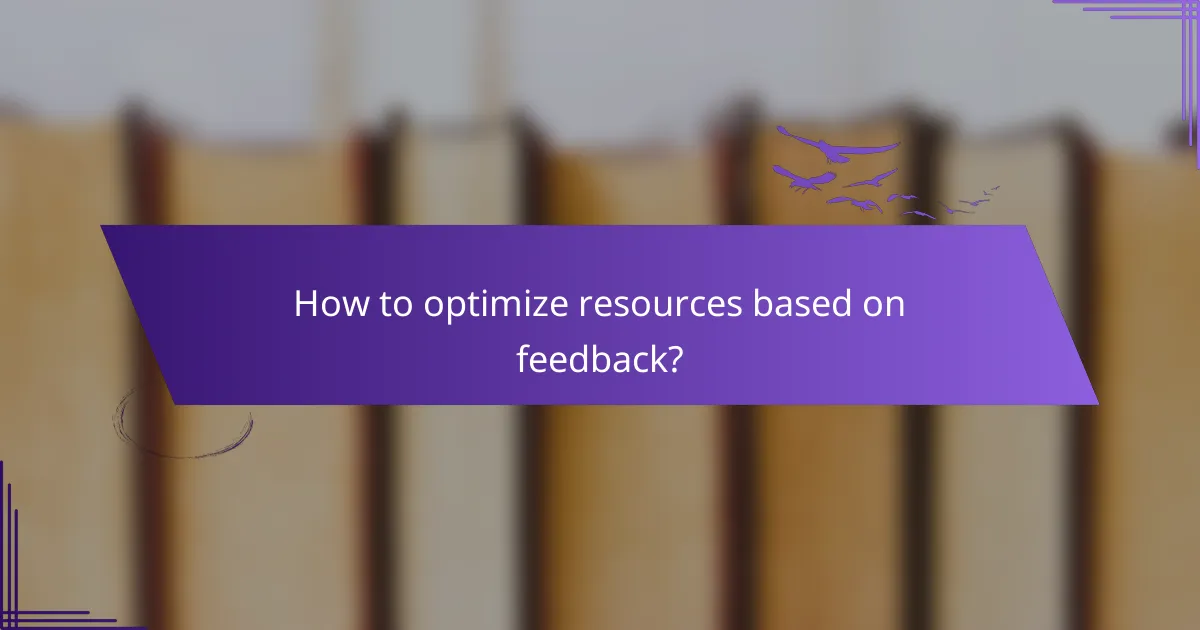Audience feedback analysis plays a crucial role in enhancing online courses by pinpointing strengths and weaknesses through learner experiences. By systematically collecting and interpreting feedback, educators can make informed adjustments that not only boost engagement but also improve overall course effectiveness.

How can audience feedback analysis improve online courses?
Audience feedback analysis enhances online courses by identifying strengths and weaknesses based on learner experiences. By systematically gathering and interpreting feedback, educators can make informed adjustments that boost engagement and effectiveness.
Enhanced course content
Analyzing audience feedback allows course creators to refine and improve course content based on student preferences and challenges. This can involve updating materials, adding relevant resources, or removing outdated information. For instance, if multiple students express confusion about a particular topic, it may be beneficial to provide additional explanations or examples.
Regularly reviewing feedback can lead to a more dynamic curriculum that evolves with student needs, ensuring that the content remains relevant and engaging. Consider implementing surveys or polls after each module to gather insights on what works and what doesn’t.
Increased student retention
Effective audience feedback analysis can significantly boost student retention rates in online courses. By understanding why students disengage, educators can address specific pain points, such as course pacing or difficulty levels. For example, if feedback indicates that students find assignments overwhelming, adjustments can be made to balance workload and improve overall satisfaction.
Additionally, fostering a responsive learning environment where students feel heard can enhance their commitment to completing the course. Regular check-ins and feedback loops can create a sense of community and support, encouraging learners to stay engaged.
Personalized learning experiences
Audience feedback analysis enables the creation of personalized learning experiences tailored to individual student needs. By collecting data on learning styles and preferences, educators can offer customized resources, such as supplementary materials or alternative assessment methods. This approach caters to diverse learner profiles, enhancing overall engagement.
For example, if feedback reveals that a segment of students prefers visual aids over text-based resources, incorporating more videos or infographics can improve their learning experience. Implementing adaptive learning technologies that respond to feedback can further personalize the educational journey, making it more effective and enjoyable for each student.

What engagement metrics should be tracked?
Tracking engagement metrics is essential for understanding how effectively your audience interacts with your content. Key metrics such as course completion rates, student satisfaction scores, and active participation levels provide insights into user behavior and areas for improvement.
Course completion rates
Course completion rates indicate the percentage of participants who finish a course relative to those who started it. A high completion rate often reflects engaging content and effective teaching methods, while low rates may signal issues with course design or delivery.
To improve course completion rates, consider implementing regular check-ins, providing incentives for completion, or breaking content into smaller, manageable modules. Aim for completion rates above 70% as a benchmark for success.
Student satisfaction scores
Student satisfaction scores measure how content participants feel about their learning experience. These scores can be gathered through surveys and feedback forms, typically on a scale from 1 to 5 or 1 to 10.
To enhance satisfaction, focus on delivering high-quality content, responsive support, and a user-friendly platform. Regularly analyze feedback to identify trends and make necessary adjustments to improve the overall experience.
Active participation levels
Active participation levels reflect how engaged learners are during the course, including metrics like forum contributions, quiz attempts, and attendance in live sessions. Higher participation often correlates with better learning outcomes.
Encourage active participation by creating interactive elements such as discussion boards, group projects, and live Q&A sessions. Aim for at least 60% of participants to engage actively to foster a collaborative learning environment.

How to optimize resources based on feedback?
To optimize resources based on feedback, organizations should analyze audience insights to streamline operations, enhance engagement, and reduce costs. This involves adjusting course materials, instructor allocation, and technology tools based on what resonates most with learners.
Streamlined course materials
Streamlining course materials means refining content to focus on what learners find most valuable. Gather feedback to identify which topics engage students and which may need simplification or removal. For example, if a significant portion of feedback indicates that certain modules are too complex, consider breaking them down into smaller, more digestible segments.
Additionally, prioritize updating materials that receive consistent low ratings. This approach not only improves learner satisfaction but also reduces the time instructors spend on less effective content. Aim for a balance between comprehensive coverage and clarity to keep learners engaged.
Efficient instructor allocation
Efficient instructor allocation involves assigning educators based on their strengths and student needs. Use feedback to determine which instructors excel in specific areas or topics and assign them accordingly. This can enhance the learning experience, as students benefit from instructors who are particularly knowledgeable and passionate about the subject matter.
Consider implementing a flexible scheduling system that allows instructors to focus on their strongest subjects while also accommodating student preferences. Regularly review instructor performance metrics and student feedback to make informed adjustments to allocations.
Cost-effective technology tools
Cost-effective technology tools can significantly enhance the learning experience while optimizing budget expenditures. Evaluate the tools currently in use based on user feedback and engagement metrics to identify which are truly beneficial. For instance, if a particular platform is underutilized, it may be worth exploring alternatives that offer similar functionalities at a lower cost.
When selecting technology tools, prioritize those that integrate well with existing systems and provide robust support. Look for options that offer free trials or tiered pricing to ensure you’re making a financially sound decision. Regularly reassess technology usage and costs to ensure ongoing efficiency and effectiveness.

What frameworks support effective feedback analysis?
Effective feedback analysis relies on structured frameworks that facilitate the collection, interpretation, and application of audience insights. These frameworks help organizations enhance engagement, improve services, and optimize resources through systematic evaluation of feedback.
Feedback loop models
Feedback loop models are essential for understanding how audience input influences decision-making processes. These models typically involve four stages: collection, analysis, action, and reassessment. By continuously cycling through these stages, organizations can ensure that feedback leads to meaningful changes.
For example, a company may gather customer feedback through surveys, analyze the data to identify trends, implement changes based on insights, and then reassess the impact of those changes through follow-up surveys. This iterative process fosters a culture of responsiveness and improvement.
Data analysis techniques
Data analysis techniques play a crucial role in transforming raw feedback into actionable insights. Common methods include sentiment analysis, trend analysis, and comparative analysis. These techniques help organizations identify patterns and gauge audience sentiment effectively.
For instance, sentiment analysis can reveal whether feedback is predominantly positive or negative, while trend analysis can highlight shifts in audience preferences over time. Employing these techniques allows organizations to prioritize areas for improvement and allocate resources efficiently.

How can qualitative feedback enhance course design?
Qualitative feedback is essential for refining course design as it provides insights into learner experiences, preferences, and challenges. By analyzing this feedback, educators can create more engaging and effective learning environments that cater to the specific needs of their students.
Identifying learner needs
Understanding learner needs is crucial for effective course design. Qualitative feedback can reveal gaps in knowledge, preferred learning styles, and specific challenges students face. For instance, open-ended survey responses may indicate that learners struggle with certain topics or prefer interactive elements over traditional lectures.
To effectively identify these needs, consider using focus groups or interviews alongside surveys. This combination allows for deeper insights and can help prioritize areas for improvement. Regularly revisiting learner feedback ensures that course content remains relevant and aligned with student expectations.
Improving instructional strategies
Qualitative feedback can significantly enhance instructional strategies by highlighting what works and what doesn’t in the classroom. For example, if students express a preference for collaborative projects, instructors can incorporate more group activities into the curriculum. This responsiveness can lead to higher engagement and better learning outcomes.
To optimize instructional strategies, analyze feedback for common themes and specific suggestions. Implement changes gradually and monitor their impact on student performance and satisfaction. Avoid making drastic alterations without sufficient evidence, as this can disrupt the learning process and confuse students.

What role does technology play in feedback analysis?
Technology is essential in feedback analysis as it streamlines data collection, enhances engagement, and improves the accuracy of insights. By leveraging various tools, organizations can efficiently gather, analyze, and act on audience feedback to optimize their offerings.
Learning management systems
Learning management systems (LMS) facilitate the collection of feedback through integrated surveys and assessments. These platforms allow educators and trainers to analyze learner performance and satisfaction in real-time, providing immediate insights into areas needing improvement.
When selecting an LMS, consider features like customizable feedback forms, reporting capabilities, and user engagement tracking. Popular options include Moodle and Canvas, which offer robust analytics tools to help identify trends and enhance learning experiences.
Survey tools and analytics
Survey tools are critical for gathering structured feedback from audiences. Platforms like SurveyMonkey and Google Forms enable organizations to create tailored surveys that can be distributed easily across various channels, ensuring a broad reach.
Utilizing analytics features in these tools helps interpret the collected data effectively. Look for options that provide visualizations, such as charts and graphs, to quickly identify patterns and areas for improvement. Regularly reviewing and adjusting survey questions based on previous responses can enhance the quality of feedback received.

What are the emerging trends in audience feedback analysis?
Emerging trends in audience feedback analysis focus on leveraging technology to enhance understanding of audience preferences and behaviors. Key developments include the use of AI for deeper insights and real-time feedback mechanisms that allow for immediate adjustments to content and strategy.
AI-driven insights
AI-driven insights utilize machine learning algorithms to analyze large volumes of audience feedback quickly and accurately. These tools can identify patterns and sentiments that may not be immediately obvious, enabling organizations to make data-informed decisions.
For instance, sentiment analysis can categorize feedback into positive, negative, or neutral, helping teams prioritize areas for improvement. Organizations should consider integrating AI tools that align with their specific needs, keeping in mind the importance of data privacy and compliance with regulations such as GDPR.
Real-time feedback mechanisms
Real-time feedback mechanisms allow organizations to gather audience opinions instantly, facilitating immediate responses to concerns or suggestions. Tools such as live polls, chatbots, and interactive surveys can engage users and provide valuable insights on their experiences.
Implementing these mechanisms can significantly enhance engagement, as audiences appreciate being heard promptly. Organizations should ensure that feedback channels are user-friendly and accessible across various platforms to maximize participation and effectiveness.


